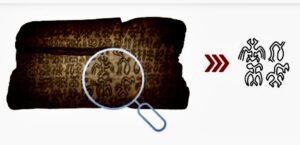
A team composed of scientists and scholars from Italy, Germany and Switzerland are suggesting that a form of writing was independently invented on Rap Nui (Easter Island) and used before European contact occurred in the early 18th century. To come to this consensus, they examined four inscribed wood tablets stored at the Congregazione dei Sacri Cuori di Gesù e di Maria, in Rome. The tablets featured a glyphic writing system known as Rongorongo, a local island script observed by outsiders in 1864. They employed radiocarbon dating techniques to date the wood upon which the script was inscribed.
“Until now, only two tablets [out of at least 27 known to exist] were directly dated, placing them in the nineteenth c. AD, which does not solve the question of independent invention,” states the study authors in the recently released paper published in Scientific Reports. “Here we radiocarbon-dated four Rongorongo tablets preserved in Rome, Italy. One specimen yielded a unique and secure mid-fifteenth c. date, while the others fall within the nineteenth c. AD. Our results suggest that the use of the script could be placed to a horizon that predates the arrival of external influence.”*
______________________

______________________
The study report* was published in Nature on February 2, 2024.
_____________________________
*Ferrara, S., Tassoni, L., Kromer, B. et al. The invention of writing on Rapa Nui (Easter Island). New radiocarbon dates on the Rongorongo script. Sci Rep 14, 2794 (2024). https://doi.org/10.1038/s41598-024-53063-7
Image, Above: Rapa Nui tablet. (A) 3D model of the Rapa Nui tablet D Échancrée. (B) Enlargement on the script. ( Ferrara, S., Tassoni, L., Kromer, B. et al., CC-BY-4.0 Deed.




